WYH2010HF Christianity 843–1648
Piety 1270-1500
Links and resources
A U of T professor investigates Chaucer's popularity among his contemporaries.
John Hus
This website from Paul Halsall at the University of North Florida links to several documents as well as several representations of death (and other themes) in late medieval art
Here's a long bibliography on death in the late middle ages.
An informative, illustrated site discussing death in late medieval art.
Late medieval popular religion
Interpretations are in flux. The older view, found among both Protestants and liberal Catholics and liturgists, was that late medieval Christians —
- had a poorly educated, privatized piety; that
- they were discouraged by the evident corruptions of the Church; and that
- their religious anxieties were exploited by a clergy-controlled sacramental system which constantly raised the question, "Are you really in a state of grace?"
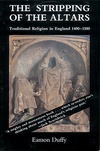 Against
this is a more recent revisionist view, promoted partly but not entirely
by conservative Catholics such as Eamon Duffy. Writing about England in
The Stripping of the Altars, he contends that late medieval Catholicism
"exerted an enormously strong, diverse, and vigorous hold over the
imagination and the loyalty of the people up to the very moment of Reformation."
Against
this is a more recent revisionist view, promoted partly but not entirely
by conservative Catholics such as Eamon Duffy. Writing about England in
The Stripping of the Altars, he contends that late medieval Catholicism
"exerted an enormously strong, diverse, and vigorous hold over the
imagination and the loyalty of the people up to the very moment of Reformation."
But others think that the revisionists have gone too far. Peter Matheson, for example, argues that late medieval religion occupied a symbolic world whose "markers were collapsing". And Keith Wrightson has shown how very little we know about some of the religious guilds on which Duffy placed so much interpretive weight.
Piety By Gordon Belyea
- Individualism. Late medieval piety reflected an emerging religious individualism, which could be interpreted as a threat to the established Church. However, the forms this piety took among the laity, particularly in areas of sexual and dietetic asceticism, were founded upon the perceived ideals of the clergy and religious orders.
- Death. A predominant theme in medieval piety was the transitory nature of life and the ultimate importance of eternity. The onset of the Black Death (ca. 1347, onwards) certainly emphasised this. See below.
- Lay movements. The period was noteworthy for the development of several lay movements and the influence of popular preachers. These often focused on the perceived ungodliness of the age and disparity in wealth. Both secular and Church authorities were ambivalent towards these movements, many of which were fuelled by the apocalyptic climate of the age (e.g., Joachim of Fiore).
- Guilds. Corporate devotional practice often took the form of guilds, in which people banded together for mutual support, both temporal and spiritual. These provided opportunities for voluntary observances beyond the requirements of the Church. See below.
- The sacramental system. After the 4th Lateran Council (1215) the sacramental system (mainly baptism, penance, and eucharist, but particularly penance) played an increasingly important role in regulating the devotional life of her members, defining the relative gravity of their sins and providing redress for the same.
- Pilgrimages, relics, holy sites. See below.
- Evidence for lay piety. The actual piety of the people
and the degree of their adherence to church regulations is difficult
to gauge. The
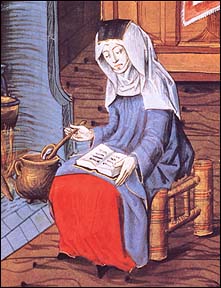 Book
of Margery Kempe (1373-1438), pictured here, an autobiographical
work (perhaps the first in English) gives a somewhat more sympathetic
view of lay piety among women than does Chaucer's "Widow of Bath".
The Book of Showings by Julian of Norwich (1390) is a more conventional
spiritual biography of an anchoress.
Book
of Margery Kempe (1373-1438), pictured here, an autobiographical
work (perhaps the first in English) gives a somewhat more sympathetic
view of lay piety among women than does Chaucer's "Widow of Bath".
The Book of Showings by Julian of Norwich (1390) is a more conventional
spiritual biography of an anchoress. - Reform movements. The late medieval period saw no sustained or widespread reform movements, as had earlier periods. The Brethren of the Common Life, primarily a lay voluntary order (at least initially), combined living in community by laity with secular work. There was no rule to these communities (in accordance with the 4th Lateran Council's moratorium on the establishment of new orders). See "devotio moderna", below.
- Hussites and Lollards. These movements, unlike the preceding
expressions of lay piety, did not fit well into the church's oversight.
While not so widespread in extent as had been the earlier movements
of the Cathari, the Humilaiti, and the Waldensians, the Hussite and
Lollard movements presented serious challenges to the church's authority.
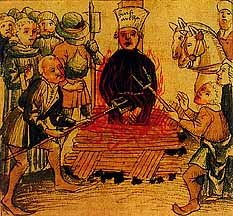 Hussites,
linked to Bohemian nationalism and arising at the same time
as national universities (e.g., Prague) began to be established
in the Empire, became essentially a separate national catholic church,
outside Roman control. John Hus, a lecturer at the University of
Prague, advocated the right of the laity to receive the Eucharist
in both kinds (ultraquism), challenged the corruption of the clergy
(both moral and financial), and asserted the priority of the Scripture
over church authority. He preached in the vernacular, Czech. He
was influenced by Wycliffe. Promised safe conduct to the Council
of Constance to defend his orthodoxy, he was there accused of heresy
and burnt at the stake (1415), pictured here.
Hussites,
linked to Bohemian nationalism and arising at the same time
as national universities (e.g., Prague) began to be established
in the Empire, became essentially a separate national catholic church,
outside Roman control. John Hus, a lecturer at the University of
Prague, advocated the right of the laity to receive the Eucharist
in both kinds (ultraquism), challenged the corruption of the clergy
(both moral and financial), and asserted the priority of the Scripture
over church authority. He preached in the vernacular, Czech. He
was influenced by Wycliffe. Promised safe conduct to the Council
of Constance to defend his orthodoxy, he was there accused of heresy
and burnt at the stake (1415), pictured here.- English Lollardy (perhaps a corruption of the term for
mumbling), the other significant heresy of the period, was not as
successful as Hussitism. This movement was heavily influenced by
Wycliffe. It de-emphasized the role of the sacraments, and criticized
the papacy and such staples of popular piety as pilgrimages and
the veneration of images. Unlike Hussitism, Lollardy was not well-organised.
In England the strong ties between Crown, lay nobility, and Church
prevented the growth of Lollardy — in contrast to Bohemia and
Hussitism.
Relics, pilgrimages
Late medieval piety continued to value relics, and pilgrimages to shrines where relics were protected. An idealized picture of a pilgrimage is presented in —
Chaucer's Canterbury Tales
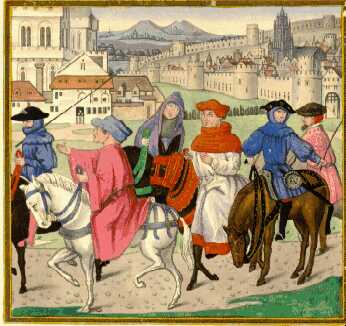 The
Canterbury Tales represents a group of English pilgrims on their
way to Canterbury to worship at the shrine of the martyr Thomas a Becket.
A prologue gives character sketches of each of the pilgrims. Then each
of the pilgrims tells a tale. Apart from its poetic interest, the work
is an exceptional entrée into the popular religion of the day.
The
Canterbury Tales represents a group of English pilgrims on their
way to Canterbury to worship at the shrine of the martyr Thomas a Becket.
A prologue gives character sketches of each of the pilgrims. Then each
of the pilgrims tells a tale. Apart from its poetic interest, the work
is an exceptional entrée into the popular religion of the day.
Chaucer
We don't know much about the life of Geoffrey
Chaucer (c. 1340-1400), the most significant English poet of his century.
He was a Londoner, and spent a year in the military in France during the
Hundred Years War. His wife 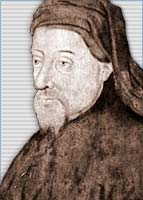 appears
to have been a sister of the wife of John of Gaunt, duke of Lancaster,
the power behind the throne during King Edward III's dotage. That gave
him influence. The government used him for diplomatic missions, and appointed
him to important government positions, such as comptroller of the customs
for certain goods coming into the port of London.
appears
to have been a sister of the wife of John of Gaunt, duke of Lancaster,
the power behind the throne during King Edward III's dotage. That gave
him influence. The government used him for diplomatic missions, and appointed
him to important government positions, such as comptroller of the customs
for certain goods coming into the port of London.
His poetry is usually divided into three periods:
- An early period, when he was inspired by French poetry, notably the Roman de la Rose;
- An Italian period, when he was inspired by Dante and Boccaccio; and
- The final period, when he wrote his masterpiece, the Canterbury Tales.
Anxiety about death
Death is one of the dominant themes of fifteenth-century art. The painting
here by Giovanni di Paolo, 1443, is characteristic of scenes personifyng
death as a figure who arrives unexpectedly as people are going for walks,
lying in beds, having picnics with lovers, and so on.  An
important sub-species is the depicition of the "dance of death".
This began as a theme in fourteenth-century drama in Germany, and became
a favourite motif of engraving and painting in the fifteenth century.
Chantries were endowments by the rich to pay for masses to be said
for their own souls or for the souls of those they loved. They can be
taken as indications of religious anxiety. Chantries multiplied in number
in the fifteenth century.
An
important sub-species is the depicition of the "dance of death".
This began as a theme in fourteenth-century drama in Germany, and became
a favourite motif of engraving and painting in the fifteenth century.
Chantries were endowments by the rich to pay for masses to be said
for their own souls or for the souls of those they loved. They can be
taken as indications of religious anxiety. Chantries multiplied in number
in the fifteenth century.
Guilds
Religious guilds (also spelled "gilds") were devotional societies which depended financially on the fees of their members and on fund-raising events such as feasts in the guildhall. They are usually seen as examples of lay-controlled piety, although recent studies suggest that they may not have been quite so lay-controlled as some scholars have believed. For a rising middle class who weren't rich enough to be able to endow chantries, they were a good discount alternative for those wanting masses said for the souls of the dead. Some also provided social services such as almshouses, hospitals, and schools.
Devotio moderna
This movement for r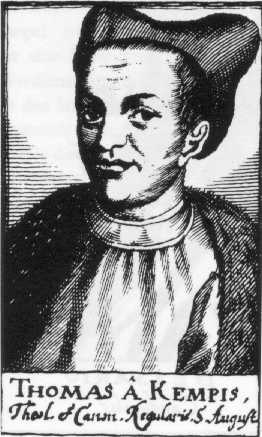 enewal
began in Holland in the late fourteenth century and had an impact in Germany,
France, and Italy. Geert de Groote (1340-1384) was its main founder. Its
characteristic expressions were communities of lay and ordained men or
women living a Christian life in towns, but not according to a rule. (There
was also a monastic version of the devotio moderna, notably among
the Windesheim canons.) The best-known literary product of the movement
was the Imitation of Christ of Thomas a Kempis.
enewal
began in Holland in the late fourteenth century and had an impact in Germany,
France, and Italy. Geert de Groote (1340-1384) was its main founder. Its
characteristic expressions were communities of lay and ordained men or
women living a Christian life in towns, but not according to a rule. (There
was also a monastic version of the devotio moderna, notably among
the Windesheim canons.) The best-known literary product of the movement
was the Imitation of Christ of Thomas a Kempis.
Its principles (borrowed from a webpage at the Episcopal Seminary of the Southwest, Austin, Texas) included:
- an appeal to the original simplicity of Christian faith in a "golden age" now evidently lost;
- a call to clergy for a truly holy life;
- a valuing of the interior life with a corresponding lack of stress on the Church's institutionalized aids to salvation;
- criticism of formalized acts of piety together with any naive reliance on the external aspects of religion;
- an insistence that the knowledge of God lay open to scholar and illiterate peasant alike;
- a soteriological urgency in the face of both human sinfulness and the ubiquitous reality of death;
- intense and emotional meditation to the suffering of Christ;
- an interpretation of the Eucharist that stresses the sacrament as mediator of an intimate relationship with Christ.